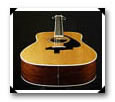Canon PowerShot G2Canon updates their very popular G1 with a 4 megapixel CCD and improved color management.<<Video, Power, Software :(Previous) | (Next): Reference: Datasheet>> Page 12:Test Results & ConclusionReview First Posted: 08/16/2001 |
Test Results
|
As with all Imaging Resource camera tests, we encourage you to let your own eyes be the judge of how well the devices performed. Explore the images on the pictures page, to see how well the G2 performed, and how its images compare to other cameras you may be considering buying.
Overall, the G2 produced excellent color, with accurate hue and saturation throughout our testing. The camera's White Balance system handled all of our test lighting well, even the difficult incandescent lighting of our Indoor Portrait (without flash). Though the Auto setting did produce a very warm image in the Indoor Portrait, the Incandescent and Manual settings did a nice job interpreting the lighting. The G2 had no problem distinguishing the tough tonal variations of our Davebox target, and reproduced the large color blocks with good accuracy and saturation. Skin tones often had a slight magenta tint, particularly in our Outdoor and Indoor portraits, but it was well within acceptable limits. The camera handled the blue flowers of our Indoor and Outdoor portraits quite well, showing little of the purple tint many cameras tend to add to these hues.
The G2 performed very well on our "laboratory" resolution test chart. It started showing artifacts in the test patterns at resolutions as low as 700 lines per picture height, in both horizontal and vertical directions. We found "strong detail" out to at least 1,100 lines. "Extinction" of the target patterns didn't occur until about 1,300 lines. Overall, an impressively sharp camera/lens combination!
Optical distortion on the G2 was a bit lower than average at the wide-angle end, where we measured an approximate 0.51 percent barrel distortion. The telephoto end fared much better, as we measured only a half-pixel of pincushion distortion. Chromatic aberration was almost nonexistent, showing only about two or three very faint pixels of coloration on either side of the target lines. The G2's lens appears to be of very high qualtity: Low distortion, great sharpness, very little aberration.
The G2 offers a full range of exposure control, including a full Manual exposure mode with shutter speeds as slow as 15 seconds. Given its exposure flexibility (and noise-reduction technology apparently ported over from Canon's Pro SLR, the EOS D30), the G2 performed very well on our low-light test. The G2 produced clear, bright, usable images down to about 1/16 foot-candle (or 0.67 lux) at all four ISO settings. Color was surprisingly accurate and overall brightness was excellent throughout the light range, even at the ISO 50 setting. The G2 automatically employs a Noise Reduction system at its slower shutter speeds, which did an excellent job of reducing image noise at low light levels. At ISO 400, noise was a little high, but the grain pattern was small and tight.
The G2's optical viewfinder was a little tight, showing approximately 86 percent frame accuracy at wide angle, and approximately 83 percent accuracy at telephoto. The LCD monitor performed much better, though it's actually just slightly loose. Our standard lines of measurement were just barely outside of the final frame, so we were unable to measure the total frame accuracy. (Call it 101%) Given that we generally prefer LCD monitors to be as close to 100 percent accuracy as possible, the G2's LCD monitor performed very well. Just remember to add a tiny bit of extra space vertically when framing with the LCD monitor.
The G2 also performed well in the macro category, capturing a minimum area of just 2.75 x 2.06 inches (69.89 x 52.42 millimeters). Color and resolution were both great, with clear details on the dollar bill and coins. The brooch details were a little soft due to the limited depth of field when shooting that close, and we also noticed some softness in all four corners of the frame. The G2's flash had some trouble throttling down for the macro area, due to the very close shooting range, and overexposed the image.
Throughout our testing, the G2 performed like a champ. Low-light and macro capabilities were outstanding, and the camera handled all of our test targets well. With its versatile exposure control, excellent color, and excellent lens, the G2 will tackle just about any shooting situation with ease.
Conclusion
We were already impressed with the capabilities of Canon's PowerShot G1. With the G2 though, Canon's improved performance in virtually every parameter. Color is better, noise and tonal range are improved, and the sharpness boost appears to be much more than just the 3 to 4 megapixel upgrade would suggest. (It's the same lens, but it looks like Canon's made a major upgrade in the G2's signal processing: The G2's images are much sharper than those from the G1.) Image noise performance has been markedly upgraded as well, thanks to technology borrowed from the Pro SLR EOS D30. At the same time, Canon has obviously listened to the G1 user community, incorporating many little tweaks that users have been asking for. (Such as the aperture behavior when working with an external flash.) Best of all, all this capability and enhanced performance come at the same suggested retail price as the G1 carried when it was first introduced. Very highly recommended, Canon's got a real winner with this one!
Reader Comments! --> Visit our discussion forum for the Canon PowerShot G2!


Follow Imaging Resource: